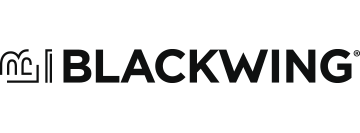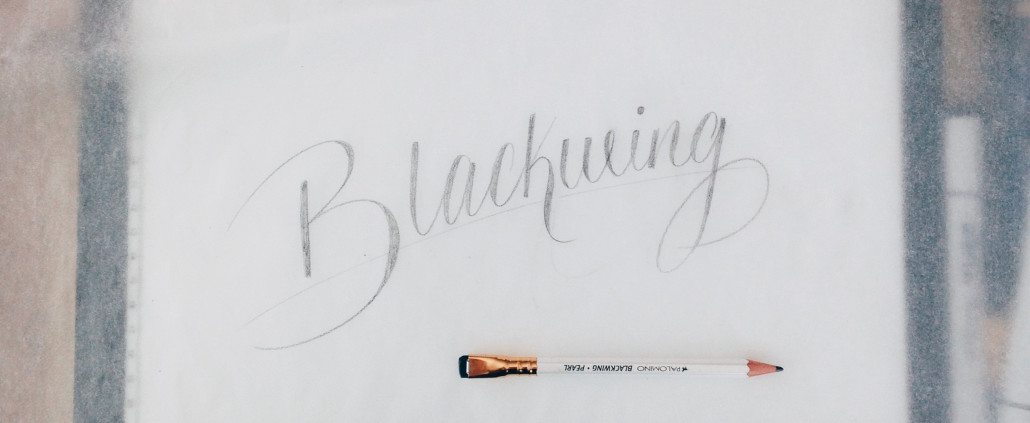Nick Sickelton on Lettering, Analog and Blackwing Pencils
Nick Sickelton is a master of the alphabet. Now, I know what you’re thinking, most people “master” the alphabet in kindergarten, but Nick has spent the better half of his life studying design, lettering and the architecture of the alphabet. He is a letterer, and he loves Blackwing pencils. And we love what he creates with them. You can check out Nick’s work at Titleca.se, or by following Nick on Twitter and Instagram.
We had a chat with Nick about lettering, Blackwing and the pencil’s place in a digital world. Enjoy.
Can you explain what a letterer is for the uninitiated?
A letterer is most simply explained as someone who studies the art of drawing letters. More complexly, a letterer is someone who creates decorative type dedicated to a specific project and, in most cases, letterers are approached when something more custom is desired. Quite opposite to typographers who study type and the letterforms of each typeface, a letterers goal is to be completely original while maintaining legibility across the canvas.
So there seems to be an analog aspect to lettering that is different from the more “digital” world of typography. Is that right?
Yes, myself and most people I follow in the type world all start by hand. There’s a feel that you cannot simulate when working on a computer and angles that a computer doesn’t understand. To work a curve with your hand is something so intimate and not only confirms that it looks good but it also feels good. And from what I see, even people designing digital type for computers usually start by hand as well. Where they divide is when they become digital. Then, typography becomes more of a process and technical product when instead, lettering can still be an organic conversation. It all comes to use and final purpose.
How did you get into lettering?
I went to college for graphic design and, during my time there, I really learned a lot about typefaces and letterforms and I found myself falling in love with the art and history of the letter. There is something special in letters that allows them to speak for themselves. They have different moods, personalities, and approachability that can really set the tone of a project, all based on a rich history and vibrant characters that have been set in place over time.
What does your creative process look like? Can you walk us through a typical lettering project, from initial concept to execution?
I try to maintain the novel process of pencil and paper first (because I’m really good at skipping steps), starting with a rough sketch by hand that eventually leads to a more refined sketch. If it’s dependant on more of a serif or swashy style, I get as close as I can to a finished project before scanning it onto my computer. I’ve learned that the letters sometimes lose their natural feel when converted to a digital format. With a san-serif or blocky type, I’m usually alright with making a quick draft and refining it in Illustrator. Once in Illustrator, I trace it completely with the pen tool and then refine by eye until it’s comfortable to read and view and add the last decorative touches. I always remember that I’m constantly having a conversation with the paper, while allowing enough planning and spontaneity to be surprised at the finished product.
Is there a place for both digital and analog tools in your work? What role do you think each format plays?
Absolutely, yes! I think each tool is important as long as you remember when to use it. A rock doesn’t make a good hammer. There’s something very refreshing about working with your hands and something very human about your work if you do and I’m always able to refine more by hand. I’m also very easily distracted with tools on a computer, which sometimes stalls my work more, so I’ve had to be very intentional about the process these days. I’m a great procrastinator. But, overall I believe that analog is so important and all too much overlooked or even skipped. The end goal though, is to make things digital. That’s where the work gets more refined and then shared. That’s always a very important part!
What inspires your work and the lettering you create?
I enjoy so many things creatively that it’s hard for me to pinpoint any one thing that gives me my main inspiration. I come from a graphic design background, so I continue to do that heavily. As an Art Director at an agency, I get a different perspective on overall vision and that definitely adds to it. For the last 10 year’s I’ve also been a pottery maker. Making my own cups, plates and whatever I feel like crafting. All of these, combined with my mood on any particular day, in most cases determines what I want to create for myself, which I make that night and share progress with people the next morning. Giving everything a 12 hour test gives me time to let it simmer and make sure I like it and, if I don’t, I archive it. Repeating this process daily with my own passion projects gives me a handful of directions to pull from when clients approach me.
I see you’re an Austin Kleon fan. What about his work and methods speak to you?
Austin is a great writer. He’s simple and understandable and he get’s his audience because I think he knows that he fits within the audience he speaks to. Something I really learned from his book “Show Your Work” was to show your process and progress. People see the finished product all the time, but what they don’t see is the way you make it happen. All too often people think that it’s a one and done process. But there’s something vulnerable in showing your unfinished work to others, with all of its human flaws and characteristics.
What is it about Blackwing pencils that make them your preferred pencil?
There’s something about the pencil that pushes the envelope of what’s “normal” while still respecting it’s heritage and upbringing. A pencil, in my opinion, is one of the most amazing tools ever created. It creates history, it teaches, and it progresses humanity. Blackwing gets to continue to play a part in that. Each Blackwing pencil feels almost like different tools with the same handle. If I want a softer and more cakey lead then I can use that just as naturally as a harder more dialed led that Blackwing offers.
On that same note, which Blackwing pencil is your favorite? Why?
Picking a favorite Blackwing would be like asking me to pick a favorite child out of triplets. Really, they’re all amazing in their own way and shouldn’t stand alone. They compliment each other so well that there’s no way I couldn’t have them all with me at any given time.
Who are some other rad people you would recommend we check out?
Over my time digging and learning about lettering more and more I have come across some people with uncapped talent. These are some of the people I’ve discovered and even reached out to from time to time. There are so many more influences I find but here are my top go to’s:
Jessica Hische | Erik Marinovich | Drew Melton | Sam Bevington | Friends Of Type

